
On October 4-5, 2018, the Armstrong Browning Library at Baylor University jointly hosted “Rhyme and Reform” with the University of Strathclyde and the University of Manchester. This symposium recognized the 175thanniversary of Elizabeth Barrett Browning’s poem “The Cry of the Children” through a series of events that fostered a critical dialogue between the poem and representations of labor by Victorian working-class authors.

Dr. Joshua King opens the “Orphans of earthly love” exhibit at the ABL. Connor Watkins and Sakina Haji, students who helped design the exhibit, join via video-conferencing.
The innovative symposium sought to bridge digital and physical spaces, with activities held at both the ABL and across the Atlantic at the University of Strathclyde in Glasgow, Scotland. Dr. Joshua King (Assoc. Prof. of English and ABL scholar in residence) and ABL Director Jennifer Borderud were the lead organizers for the ABL site, and Prof. Kirstie Blair (U of Strathclyde) and Dr. Mike Sanders (U of Manchester) were the lead organizers for the Glasgow site.
Video-conferencing allowed the two sites to interact and share events, but the “Rhyme and Reform” website also hosted an online version of the physical exhibition at the ABL and allowed participants anywhere in the world to live stream the presentations. This exhibition remains available through the website, where it is now joined by recordings of events from both symposium sites. This will allow scholars, teachers, and students to engage with “Rhyme and Reform” long after its official end. One teacher has already written a blog about her class’s experience of “Rhyme and Reform.”
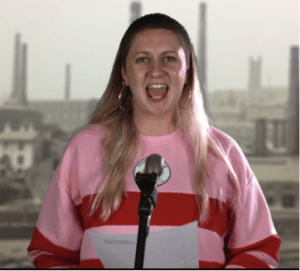
Jennifer Reid sings a nineteenth-century working-class ballad
One of the highlights of “Rhyme and Reform” was an arresting performance of narrative and balladry by Jennifer Reid and Dr. Mike Sanders depicting nineteenth-century working-class life in Manchester, England. You can hear a 15-minute excerpt of the performance here.
The symposium also included engaging and insightful talks by top scholars including Prof. Marjorie Stone (Dalhousie U) and Prof. Beverly Taylor (UNC), both leading experts on EBB, and Prof. Florence Boos (U of Iowa), an authority on Victorian working-class women poets. You can listen to their talks on the symposium website here. Be sure explore the “Sessions” tab on the website to find recordings of the other talks from both sides of the Atlantic.
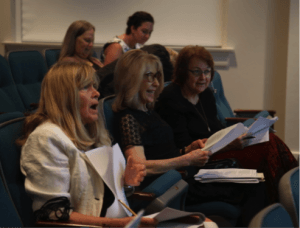
Prof. Marjorie Stone, Prof. Linda Hughes, Prof. Florence Boos (Front L-R), Dr. Melinda Creech, and Rachel Kilgore (Back L-R) participate in the ABL COVE workshop on EBB’s poem.
Both the University of Strathclyde and ABL sites participated in workshops on digital scholarship and teaching using COVE. They used the suite of the digital tools to collaboratively annotate EBB’s “The Cry of the Children,” with the intention of ultimately building an online scholarly edition of the poem.
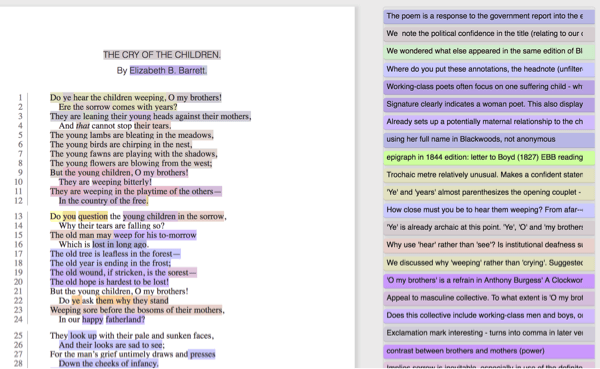
The working annotations of EBB’s poem following the ABL’s and University of Stathclyde’s COVE workshops.
And finally, “Rhyme and Reform” also included a physical exhibit on “The Cry of the Children” at the ABL created by Dr. Joshua King’s spring 2018 Victorian Poetry senior seminar: “Orphans of earthly love: Elizabeth Barrett Browning’s Protest for Working Children.” The exhibition also appears online on the symposium website alongside an exhibition of working-class poetry from “Piston, Pen & Press,” an AHRC-funded project directed by Prof. Kirstie Blair and Dr. Mike Sanders on the literary cultures of industrial workers in the North of England and Scotland. Click here to visit the two online exhibitions and consider how their juxtaposition invites you to compare EBB’s “The Cry of the Children” with working-class verse.
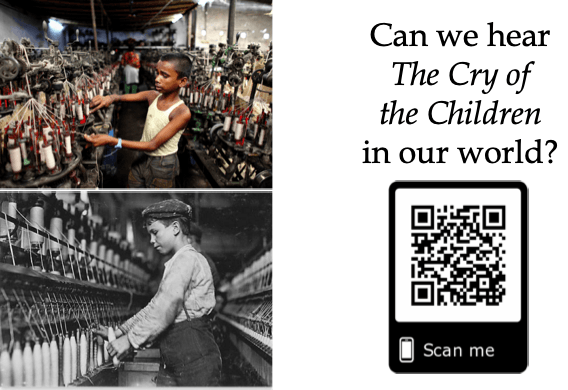
These two young boys working looms in factories—one in the nineteenth century and one in the present—appeared in the physical exhibit at the ABL. Viewers were encouraged to engage in the exhibit by scanning the QR code to “hear” echoes of “The Cry of the Children” in the present day.
The dual-site, digitally connected nature of this symposium allowed international collaboration and participation with limited travel and thus a reduced economic and environmental impact. Further, it opened access to the events across the world. You can see some of interactions among participants by viewing the hashtag #RhymeandReform on Twitter. Over just the two days, the symposium website received nearly 200 visitors from seven countries. Some of these included groups of faculty and students, such as the self-organized viewing by the University of Regina in Saskatchewan, Canada. Thus, we estimate “Rhyme and Reform” engaged around 260 participants, the audience size of an annual conference for a mid-sized scholarly association.
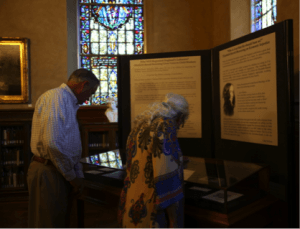
Visitors view rare materials from the ABL at the “Orphans of earthly love” exhibit.
We encourage you to visit the “Rhyme and Reform” website yourself to take part in the symposium. And if you’re in the Waco, TX area, be sure to visit the physical exhibition at the Armstrong Browning Library, which will be on display on the main floor through April 1, 2019.
